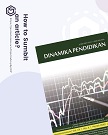Financial Inclusion in Home Industry of Bamboo Handicrafts in The Trenggalek District
(1) Universitas Negeri Malang
(2) Universitas Negeri Malang
(3) Universitas Negeri Malang
Abstract
This study aimed to analyze the conditions of financial inclusion in home industry of the bamboo handicrafts and their implications for business performance. The approach used in this research was a qualitative approach, type of case study research. Data collection methods used were interviews and observation. The results of this study indicated that most of the craftsmen were still classified as unbanked people and did not yet have a bank account. The craftsman considered that it was not too important to have a bank account because of the lack of income and low understanding of financial services and products. Significant profit differences made the creation of three classes of craftsmen in the village of Wonoanti. Productivity among craftsmen had a significant difference, caused by the production machines and the number of employees. So, financial inclusion in each craftsman was different. This difference in the level of financial inclusion resulted in differences in business performance between craftsmen classes. The level of financial inclusion was directly proportional to the business performance of each craftsman..
Keywords
Full Text:
PDFReferences
Adriani, D., & Wiksuana, I. G. B. (2018). Inklusi Keuangan Dalam Hubungannya Dengan Pertumbuhan Umkm Dan Tingkat Kesejahteraan Masyarakat Di Provinsi Bali. E-Jurnal Manajemen Universitas Udayana, 7(12), 6420. https://doi.org/10.24843/ejmunud.2018.v07.i12.p02
Allen, F., Demirguc-Kunt, A., Klapper, L., & Martinez Peria, M. S. (2016). The foundations of financial inclusion: Understanding ownership and use of formal accounts. Journal of Financial Intermediation, 27(December), 1–30. https://doi.org/10.1016/j.jfi.2015.12.003
Tiwari, Aviral Kumar, M. S. (2013). Does Financial Development increase Rural-Urban Income Iequality. 1–19.
Azhar, M. A., & Harif, M. (2010). Financial Management Practices an Indepth Study Among the CEO of Small and Medium Enterprise (SMEs). 04, 1–37. https://pdfs.semanticscholar.org/5969/a1c301bc710626587d08228d8e73311fd111.pdf?_ga=2.99280734.1927837072.1585909675-2111233013.1585909675
BPS Trenggalek. (2019). Kecamatan Gnadusari dalam Angka. https://trenggalekkab.bps.go.id/publication/download.html?nrbvfeve=NDFkNWRmNDgzODBjNzQ4MTc2NWZhZTRh&xzmn=aHR0cHM6Ly90cmVuZ2dhbGVra2FiLmJwcy5nby5pZC9wdWJsaWNhdGlvbi8yMDE5LzA5LzI2LzQxZDVkZjQ4MzgwYzc0ODE3NjVmYWU0YS9rZWNhbWF0YW4tZ2FuZHVzYXJpLWRhbGFtLWFuZ2thLT
Demirguc-Kunt, A., Klapper, L., Singer, D., Ansar, S., & Hess, J. (2018). The Global Findex Database 2017: Measuring Financial Inclusion and the Fintech Revolution. In The Global Findex Database 2017: Measuring Financial Inclusion and the Fintech Revolution. https://doi.org/10.1596/978-1-4648-1259-0
Dhar, V., & Stein, R. M. (2017). Economic and business dimensions: FinTech platforms and strategy. Communications of the ACM, 60(10), 32–35. https://doi.org/10.1145/3132726
Gardeva, A., & Rhyne, E. (2011). Opportunities and Obstacles to Financial Inclusion. https://www.centerforfinancialinclusion.org/opportunities-and-obstacles-to-financial-inclusion
Global Findex. (2017). Financial Inclusion Indicators in Poland: Vol. Acta Unive. https://openknowledge.worldbank.org/bitstream/handle/10986/29510/211259ov.pdf?sequence=3&isAllowed=y
Indonesia, B. (2020). jumlah perbankan. https://www.bps.go.id/statictable/2020/01/21/2082/bank-dan-kantor-bank-2014-2018.html
Kemenko. (2018). Keberpihakan pemerintah terhadap u.m.k.m. 1–24. http://fmb9.id/document/1530868590_PPh_UMKM_(6_Juli_2018)_Iskandar_S.pdf
Latifah, L., Setiawan, D., & Aryani, Y. (2019). The Recent Research Development on Micro Small and Medium Enterprises in Indonesia. Dinamika Pendidikan, 14(1), 1-12. doi:https://doi.org/10.15294/dp.v14i1.14287
Mago, S., & Chitokwindo, S. (2014). The impact of mobile banking on
financial inclusion in Zimbabwe: A case for Masvingo province. Mediterranean Journal of Social Sciences, 5(9), 221–230. https://doi.org/10.5901/mjss.2014.v5n9p221
Oluwatayo, I. (2013). Banking the unbanked in rural southwest Nigeria: Showcasing mobile phones as mobile banks among farming households. Journal of Financial Services Marketing, 18(1), 65–73. https://doi.org/10.1057/fsm.2013.2
Otoritas Jasa Keuangan. (2019). Siaran Pers Survei OJK 2019: Indeks Literasi Dan Inklusi Keuangan Meningkat. In Sp 58/Dhms/Ojk/Xi/2019 (Issue November). https://www.ojk.go.id/id/berita-dan-kegiatan/siaran-pers/Documents/Pages/Siaran-Pers-Survei-OJK-2019-Indeks-Literasi-Dan-Inklusi-Keuangan-Meningkat/SP - SURVEI OJK 2019 INDEKS LITERASI DAN INKLUSI KEUANGAN MENINGKAT.pdf
Otoritas Jasa Keuangan. (2020). Statistik Lembaga Pembiayaan. https://www.ojk.go.id/id/kanal/iknb/data-dan-statistik/lembaga-pembiayaan/Pages/Statistik-Lembaga-Pembiayaan-Periode-Februari-2020.aspx
Sanjaya, I. M., & Nursechafia, N. (2016). Financial Inclusion And Inclusive Growth: A Cross-Province Analysis In Indonesia. Buletin Ekonomi Moneter dan Perbankan, 18(3), 281-306.
Sanistasya, P. A., Raharjo, K., & Iqbal, M. (2019). The Effect of Financial Literacy and Financial Inclusion on Small Enterprises Performance in East Kalimantan. Jurnal Economia, 15(1), 48–59. https://doi.org/10.21831/economia.v15i1.23192
Sarma, M., & Pais, J. (2011). Financial Inclusion and Development: A Cross Country Analysis. Mediterranean Journal of Social Sciences, 1–30. https://doi.org/10.5901/mjss.2014.v5n9p221
Shankar, S. (2013). Financial inclusion in India: Do microfinance institutions address access barriers. Pdfs.Semanticscholar.Org, 2(1), 60–74. https://pdfs.semanticscholar.org/4ad4/3e14111bd6a5ac1bd61949e16d3b0cdbd90e.pdf
Soederberg. (2018). Universalising Financial Inclusion and the Securitisation of Development (Vol. 34, Issue 4). https://doi.org/10.1080/01436597.2013.786285
Tiwari, A. K., & Shahbaz, M. (2010). Does financial development increase rural-urban income inequality? Cointegration analysis in the case of Indian economy. MPRA Paper No. 27093, 27093. https://doi.org/10.5897/JAERD12.088
Ummah, B. B., Nuryartono, N., & Anggraeni, L. (2018). ANALISIS INKLUSI KEUANGAN DAN PEMERATAAN PENDAPATAN DI INDONESIA. JURNAL EKONOMI DAN KEBIJAKAN PEMBANGUNAN, 4(1), 1–27. https://doi.org/10.29244/jekp.4.1.1-27
UU No. 9 tahun 1995. (1995). UU Republik Indonesia No 9 Tahun 1995 Tentang Usaha Kecil (pp. 1–11). http://perundangan.pertanian.go.id/admin/uu/UU-09-95.pdf
Wihartanti, L., Nurhuda, N., & Munafi’ah, B. (2018). Implementation of Accounting Education Learning Through Living Laboratory in MSMEs. Dinamika Pendidikan, 13(2), 238-242. doi:https://doi.org/10.15294/dp.v13i2.17634
Refbacks
- There are currently no refbacks.

This work is licensed under a Creative Commons Attribution 4.0 International License.

.png)

.png)





